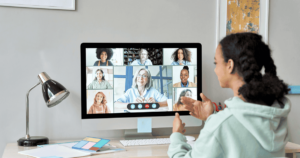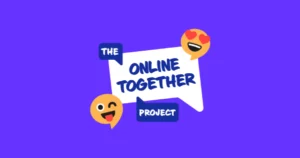Supporting online learning at home
Advice for parents who homeschool
Get advice on support children’s online safety while they learn remotely using connected tech.

In this guide
- Supporting primary-aged children
- Supporting secondary-aged children
- Advice for children and young people
- Supporting resources
Supporting primary school-aged children
As children begin to engage in learning online, it’s important to build a foundation of good online habits.
- If you cannot provide separate devices dedicated to learning, create accounts for that purpose. When they have focused learning time, they can use those accounts, which you can add specific apps and restrictions on.
- Keep their device in a common space such as the kitchen or living room. If they need fewer distractions, create a private learning zone within these spaces in a way that makes them feel comfortable.
- Set timers and transition reminders to help them switch focus between topics or to an offline activity. Remember that children’s attention spans are not the same as adults or even teens, so schedule frequent breaks.
- Complete online activities with them to help them stay focused. This will also help you clarify any concepts they don’t understand.
- Create a routine of check-ins if your child likes to work more independently. For example, if you schedule breaks for every twenty minutes, then maybe you schedule a short check-in every 18 minutes to help them review their learning.
- Listen to their concerns or things they struggle with and adapt their learning space for these difficulties.
- Whatever your child learns with their online lessons, make sure you consolidate that learning offline. For example, if they’re learning about adding, you could get them to apply their knowledge at the shop later.
- Talk about what they’ve learned using news or other scenarios.
- Ask them to teach you any new concepts they’ve learned to help them remember for the next lesson.
Resources for primary-aged children
Use our following resources to support your child’s media literacy at home.
Supporting secondary school-aged children
As teenagers develop their understanding of the world, you can use connected technology to support them.
Secondary school-aged children use the online space to connect with friends and build relationships. If they’re homeschooled, this might be a way to stay in contact with friends they don’t always see every day.
So, as a part of their learning, make sure you manage their wellbeing.
- Encourage regular breaks and movement.
- If they attend digital classes where cameras need to be on, help them create a space they feel confident in. This might include designating a nicely decorated space for them to use.
- Support regular routines that include getting ready for their school day — even if they don’t go to physical school. This often helps support young people with anxiety or depression to start the day with positivity.
Digital footprints refer to the information that your child leaves behind as they browse online. This can include information they tell to other users as well as cookies and other data that platforms collect.
Talk with teens about their digital footprint and how their online interactions add to it. This also applies to their schoolwork and the websites they might hold accounts for learning.
Encourage them to:
- Avoid sharing private or personal information with others or on digital tools (like with AI tools);
- Only comment things they would be happy for their parents, friends, etc. to see;
- Keep profiles private.
There are a range of online resources that teens can use to learn about different subjects. Involve your child in the choices around which platforms they use when creating your homeschooling curriculum.
Resources to support teens with learning online include:
Remember that interest-based learning should supplement Maths and English.
Resources for secondary-aged children
Use our following resources to help your child develop their media literacy and digital resilience as they learn.
Advice for children and young people
If your child attends live online classes, the following advice can support their positive learning experience.
Hi, I’m Dr. Linda Papadopoulos, a psychologist. Today, I want to speak to you about remote learning and how you can work with the adults in your life, your teachers, parents, or caregivers, to make the experience easier and better for you.
So, there are a couple of things you can do to make learning from home a lot easier. The first one is to ask yourself: “How am I set up at home? Can I see the screen well? Can I hear it well?” If the answer is no or you’re not sure, it’s really important to tell one of the adults in your life.
Similarly, you have to ask yourself: “What is my communication in class like? Am I understanding the teacher? Do I understand how to get my ideas across? Is it hard for me to, you know, put up my hand the way I used to in class and be listened to? Or do I feel weird about kind of having to say something when I see myself on screen?” Any of these things that feel odd or uncomfortable, it’s really important that you speak to a parent, your guardian, or your teacher about, so you can work together to sort it out.
And I think finally, and really, really importantly, don’t be afraid to ask for help. You know, you’re learning online for the first time, but actually, so are your teachers, who are trying to support you. Your parents, and the more information that we have from you, the easier it will be to kind of have that learning environment that gives you the most of everything that you need. I hope this helps.
 Close video
Close video
- Ask yourself if you can see and hear live lessons when you’re at home.
- Work with your parent or primary caregiver to ensure you have everything set up so you feel comfortable.
- Have you been able to speak to your teacher/classmates or do you feel like you need to speak to them more?
- How are you being called on in class?
- Are you happy to speak up during live lessons? If not, speak to your parent or primary caregiver. There will be a number of ways they can help you and work with your teacher to find a solution.
Hi, I’m Dr. Linda Papadopoulos, a psychologist. Today, I want to speak to you about remote learning and how you can work with the adults in your life, your teachers, parents, or caregivers, to make the experience easier and better for you.
So, first I wanted to speak about this sense of feeling more exposed now. That’s inevitable when you’re learning online because in some ways, you’re confronted with your own face constantly. You can see the background of your room and everyone else can see it, and when you speak, you really feel like the focus is on you. But actually, if you think about it, a lot of these things can be helped and moderated and kind of thought about in a different way.
I think first and foremost, you’re much more aware of how you look than anyone else’s, and the reason for that is because they’re thinking about how they look. So, you need to keep that in mind. Secondly, practical things like, you know, not wanting to expose the background can be done easily using technology, right? So, either find a blank wall or if you can’t do that, you can blur the background.
And thirdly, and I think this is an important one, when you, you know, when you feel you have to speak up or you feel everyone’s looking at you, that’s actually one of those times that you can really think critically about what’s going on. Were you always shy in classes? Is it always difficult? And if that was the case, I would say absolutely speak to a teacher about how to make it easier for you. There may be ways where you can feed into class in a different way, or you can be called upon when you’re ready. But ultimately, there’s an important part of being able to kind of engage with the class in a way that makes you feel comfortable, but also that you know doesn’t make you feel stifled because you’re able to push back on the worries that you have. Sometimes we react to our anxiety rather than what’s really going on, and it’s important to remember this.
I really hope you found these tips useful, and remember, if you are having issues, this isn’t something you should contend with on your own. You know, the adults in your life, your teachers, your parents, your caregivers, they’re all there to help you out. So, make sure to speak to them, and always for more information, go to www.internetmatters.org. Thanks for listening.
 Close video
Close video
Start by talking about exposure – you may feel that you’re more exposed than usual due to having your camera on during remote lessons.
Perhaps when you see a big picture of yourself on the screen you feel more self-aware but actually, everyone’s very self-aware of themselves anyway.
In actual fact, this isn’t any different to normal when you’re sat in a classroom, next to a classmate. It’s the same level of exposure, we’re just more aware of it.
Talk about some individual issues and how they can be resolved, for example:
- Perhaps you don’t feel comfortable having your bedroom on show as it’s your personal space. Don’t be afraid to speak to your parent or primary caregiver about this, there are options you can explore. In this instance, your parent could speak to your teacher and see if you can blur out or use an alternative suitable background.
- Perhaps you don’t like speaking up on camera/in class but I’d ask you to challenge yourself on this. Ask yourself was this an issue before? Were you happy to speak up when in the classroom?
- Technology can really amplify things that may have already been there so it’s a great teachable moment for us. It’s likely ‘I didn’t become shy because of new classes, I was probably always shy and it’s just come to a head now’. How do we make this easier? The answer is it’s about using a voice. Is it about trying it with different groups of people?
Supporting resources
Use these resources for more support with your homeschooling needs.

My Family's Digital Toolkit
Get personalised advice based on your child's age, activities and needs.





